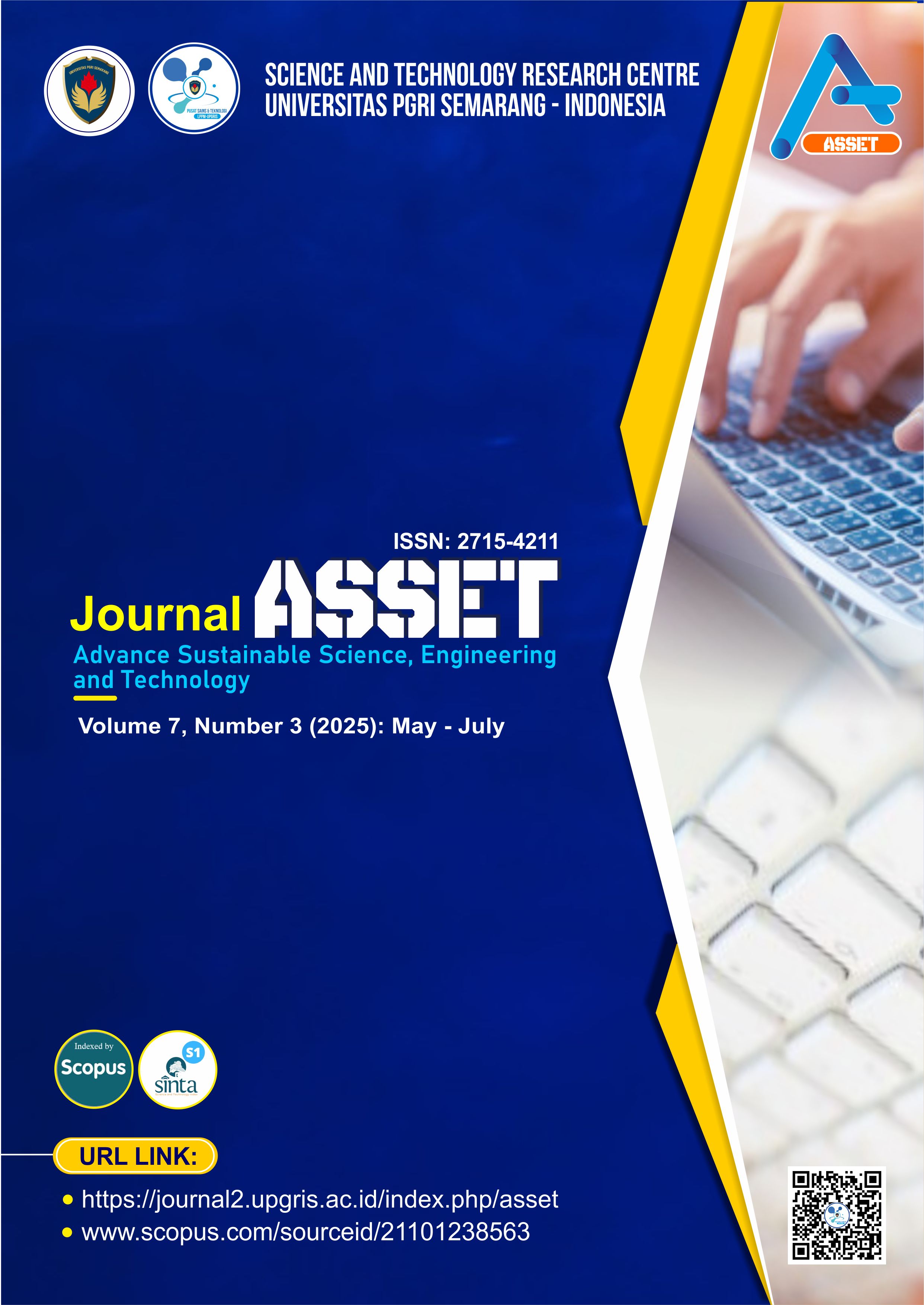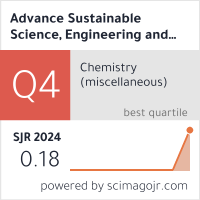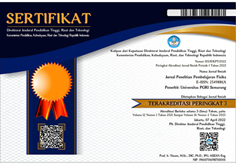Dual-Chamber Microbial Fuel Cell for Bioelectricity Generation Using Coastal Sediments: A Case from Kendari Bay
DOI:
https://doi.org/10.26877/asset.v7i4.2086Keywords:
Kendari Bay Sediment, bioeletricity, SMFCAbstract
This study evaluates the potential of Kendari Bay sediment as an alternative source of electrical energy through the dual-chamber Sediment Microbial Fuel Cell (SMFC) technology. The research focused on sediment characterization, performance analysis using an aerator and KMnO₄, post-operation substrate changes, and the identification of electrogenic bacteria. The results showed that the sediment contained 43.24% moisture, 4.23% organic carbon, 1.08% total nitrogen, a C/N ratio of 3.92, pH 7.38, and conductivity of 11.56 mS. The SMFC generated a voltage of 0.404 V (aerator) and 1.628 V (KMnO₄), along with a current of 5.0 µA. After SMFC operation, organic content decreased, with 42.65% moisture, 4.06% organic carbon, 0.97% total nitrogen, a C/N ratio of 4.19, pH 7.86, and conductivity of 15.78 mS. Identified bacteria were Gram-positive Bacillus spp. These findings demonstrate that aerator and KMnO₄ application in dual-chamber SMFC significantly enhance energy conversion efficiency using marine sediment.
References
[1] Alwahab A, Maharani PT, Nur K. WOM, Ahmad LO, Alimin A, Zaeni A. Optimization of Biogas Liquid Waste from Livestock Manure as a Source of Renewable Energy through Microbial Fuel Cell (MFC) Technology. ASSET. 2024 Mar 9;6(2):0240202. DOI:10.26877/asset.v6i2.17931
[2] World Energy Outlook 2023.
[3] Sinar U. Indonesia Renewable Energy Investment Outlook – Semester 2 2023.
[4] Zaeni A, Susilowati PE, Alwahab, Ahmad LO. Renewable energy from sediment microbial fuel cell technology from Kendari Bay swamp sediments. In Surakarta, Indonesia; 2020. p. 020004. DOI: https://doi.org/10.1063/5.0011271
[5] Alif A, Jalil Baari M, Febryanti A. Performance of Sediment Microbial Fuel Cells in Generating Electricity using Fish Wastewater and Shrimp Wastewater as a Nutrient and Their Effect on Waste Quality. International Journal of Science, Technology & Management. 2023 Jan 9;4(1):7–13. DOI: https://doi.org/10.46729/ijstm.v4i1.673
[6] Fan L, Shi J, Xi Y. PVDF-Modified Nafion Membrane for Improved Performance of MFC. Membranes. 2020 Aug 13;10(8):185. DOI: https://doi.org/10.3390/membranes10080185
[7] Lawan J, Wichai S, Chuaypen C, Nuiyen A, Phenrat T. Constructed sediment microbial fuel cell for treatment of fat, oil, grease (FOG) trap effluent: Role of anode and cathode chamber amendment, electrode selection, and scalability. Chemosphere. 2022 Jan;286:131619. DOI: https://doi.org/10.1016/j.chemosphere.2021.131619Get rights and content
[8] Sudarman R, Zaeni A, Usman I, Alwahab, Hidayatulloh I. Optimization of electricity generation from marine sediment of Kendari Bay using stacked sediment microbial fuel cell. J Phys: Conf Ser. 2020 Feb 1;1450(1):012111. DOI: 10.1088/1742-6596/1450/1/012111
[9] Fitrianti F, Zainal PF, T S, Muhajirah E, Zaeni A, Ardiansyah, et al. Characterization of Potential Microbial Fuel Cell (MFC) Producing Bacteria from Mangrove Sediment Substrate. Int J Sci Tech Health. 2025 July 30;3(2):78–84. DOI: https://doi.org/10.63441/ijsth.v3i2.54
[10] Zhang H, Hou D, Zhang S, Cao X, Wang H, Li X. Aerobic Denitrification Is Enhanced Using Biocathode of SMFC in Low-Organic Matter Wastewater. Water. 2021 Dec 9;13(24):3512. DOI: https://doi.org/10.3390/w13243512
[11] Wang CT, Lee YC, Liao FY. Effect of Composting Parameters on the Power Performance of Solid Microbial Fuel Cells. Sustainability. 2015 Sept 15;7(9):12634–43. DOI: https://doi.org/10.3390/su70912634
[12] Najafgholi Z, Rahimnejad M, Najafpour G. Effect of Electrolyte Conductivity and Aeration on Performance of Sediment Microbial Fuel Cell. JREE. 2015. 2(1). DOI: https://doi.org/10.3390/su70912634
[13] Wang CT, Lee YC, Liao FY. Effect of Composting Parameters on the Power Performance of Solid Microbial Fuel Cells. Sustainability. 2015 Sept 15;7(9):12634–43. DOI: https://doi.org/10.3390/su70912634
[14] Kanani B, Zahedi A, Abtahi F, Abedi S. Exploring operational barriers in microbial fuel cells: Enhancing energy recovery from wastewater. Electrochemistry Communications. 2025 Nov;180:108051. DOI: https://doi.org/10.1016/j.elecom.2025.108051
[15] Hazzan OO, Zhao B, Xiao Y. Strategies for Enhancing Extracellular Electron Transfer in Environmental Biotechnology: A Review. Applied Sciences. 2023 Nov 28;13(23):12760. DOI: https://doi.org/10.3390/app132312760
[16] Mohd Noor NN, Jeong I, Yoon S, Kim K. Utilization of Spent Coffee Grounds for Bioelectricity Generation in Sediment Microbial Fuel Cells. Microorganisms. 2024 Mar 19;12(3):618. DOI: https://doi.org/10.3390/microorganisms12030618
[17] Li Y, Zong Y, Feng C, Zhao K. The Role of Anode Potential in Electromicrobiology. Microorganisms. 2025 Mar 11;13(3):631. DOI: https://doi.org/10.3390/microorganisms13030631
[18] Oktavitri NI, Soegianto A, Isnadina DRM, Amin MHF, Chakraborty A, Thung W, et al. Hybrid sediment microbial fuel cells utilizing Spirulina platensis for concurrent energy harvesting, pollutant removal, and algal biomass production. Global J Environ Sci Manage. 2025. 11(4). DOI: DOI: 10.22034/gjesm.2025.04.05
[19] Włodarczyk B, Włodarczyk PP. Microbial Fuel Cell with Cu-B Cathode and KMnO4 Catholyte. Infrastruktura Ekologia Terenów Wiejskich / Infrastructure and Ecology of Rural Areas. 2017;(IV/3/2107):1823–31. DOI: http://dx.medra.org/10.14597/infraeco.2017.4.3.137
[20] Minutillo M, Di Micco S, Di Giorgio P, Erme G, Jannelli E. Investigating Air-Cathode Microbial Fuel Cells Performance under Different Serially and Parallelly Connected Configurations. Energies. 2021 Aug 19;14(16):5116. DOI: https://doi.org/10.3390/en14165116
[21] Agüero-Quiñones R, Ávila-Sánchez Z, Rojas-Flores S, Cabanillas-Chirinos L, De La Cruz-Noriega M, Nazario-Naveda R, et al. Activated Carbon Electrodes for Bioenergy Production in Microbial Fuel Cells Using Synthetic Wastewater as Substrate. Sustainability. 2023 Sept 15;15(18):13767. DOI: https://doi.org/10.3390/su151813767
[22] Oh SE, Logan BE. Voltage reversal during microbial fuel cell stack operation. Journal of Power Sources. 2007 May;167(1):11–7. DOI: https://doi.org/10.1016/j.jpowsour.2007.02.016
[23] Arsov GL, Georgievski G. Preliminary Design of a PEM Fuel Cell Simulator Based on Digitally Controlled DC-DC Buck Converter. Electronics. 2009. 13(1).
[24] Ewing T, Ha PT, Beyenal H. Evaluation of long-term performance of sediment microbial fuel cells and the role of natural resources. Applied Energy. 2017 Apr;192:490–7. DOI: https://doi.org/10.1016/j.apenergy.2016.08.177
[25] Ye T ran, Song N, Chen M, Yan Z sheng, Jiang HL. No enhancement of cyanobacterial bloom biomass decomposition by sediment microbial fuel cell (SMFC) at different temperatures. Environmental Pollution. 2016 Nov;218:59–65. DOI: 10.1016/j.envpol.2016.07.054
[26] Ojha R, Dash J, Satpathy SS, Ojha PC, Pradhan D. A brief review on factors affecting the performance of microbial fuel cell and integration of artificial intelligence. Discov Sustain. 2025 July 28;6(1):702. DOI: https://doi.org/10.1007/s43621-025-01619-6
[27] Bird H, Heidrich ES, Leicester DD, Theodosiou P. Pilot-scale Microbial Fuel Cells (MFCs): A meta-analysis study to inform full-scale design principles for optimum wastewater treatment. Journal of Cleaner Production. 2022 Apr;346:131227. DOI: https://doi.org/10.1016/j.jclepro.2022.131227
[28] Yu B, Feng L, He Y, Yang L, Xun Y. Effects of anode materials on the performance and anode microbial community of soil microbial fuel cell. Journal of Hazardous Materials. 2021 Jan;401:123394. DOI: https://doi.org/10.1016/j.jhazmat.2020.123394
[29] Angenent LT, Karim K, Al-Dahhan MH, Wrenn BA, Domíguez-Espinosa R. Production of bioenergy and biochemicals from industrial and agricultural wastewater. Trends in Biotechnology. 2004 Sept;22(9):477–85. DOI: https://doi.org/10.1016/j.tibtech.2004.07.001
[30] Hadwan MH, Hussein MJ, Mohammed RM, Hadwan AM, Saad Al-Kawaz H, Al-Obaidy SSM, et al. An improved method for measuring catalase activity in biological samples. Biology Methods and Protocols. 2024 Jan 11;9(1):bpae015. DOI: 10.1093/biomethods/bpae015
[31] Whaley DN, Dowell VR, Wanderlinder LM, Lombard GL. Gelatin agar medium for detecting gelatinase production by anaerobic bacteria. J Clin Microbiol. 1982 Aug;16(2):224–9. DOI: 10.1128/jcm.16.2.224-229.1982
[32] Hlordzi V, Kuebutornye FKA, Afriyie G, Abarike ED, Lu Y, Chi S, et al. The use of Bacillus species in maintenance of water quality in aquaculture: A review. Aquaculture Reports. 2020 Nov;18:100503. DOI: https://doi.org/10.1016/j.aqrep.2020.100503











